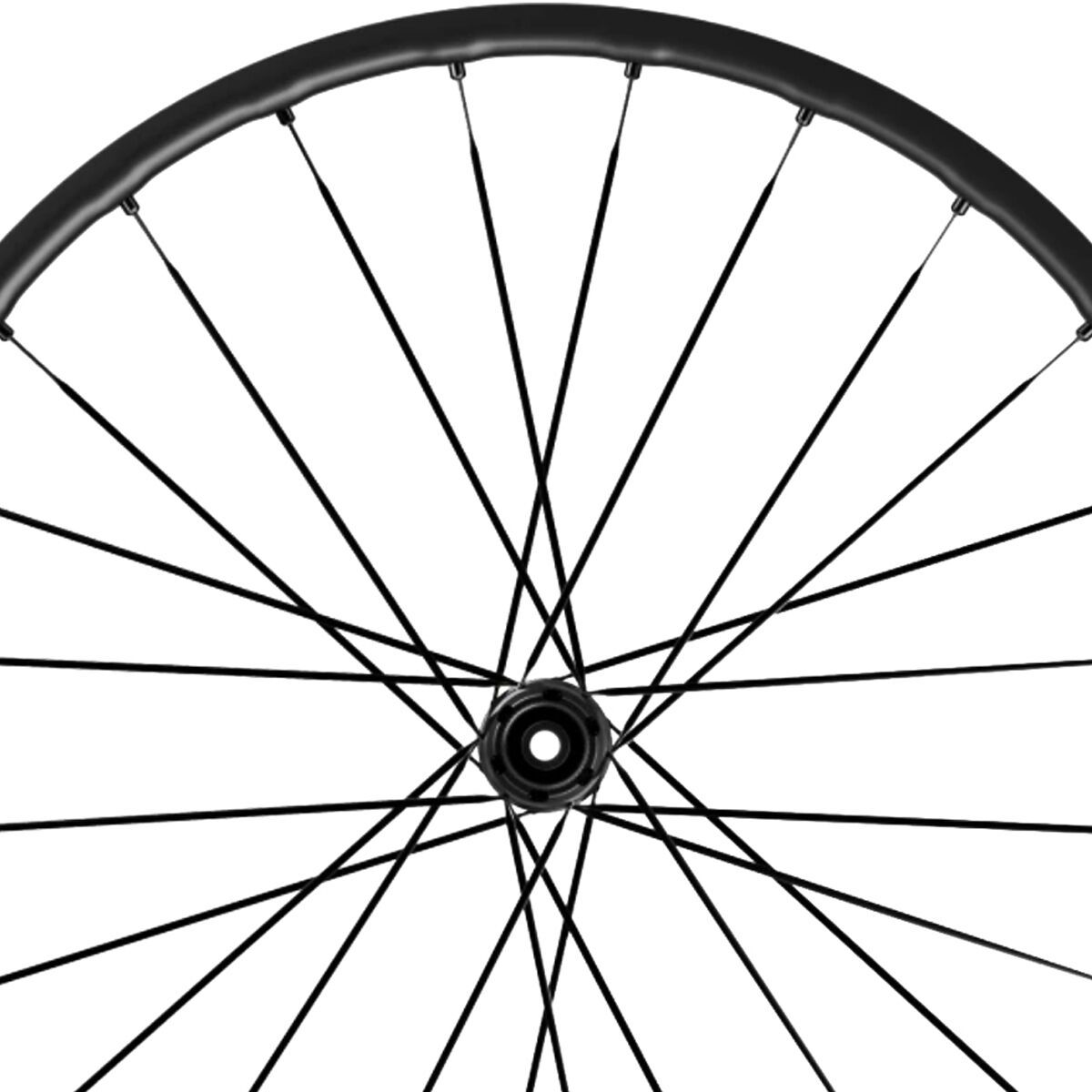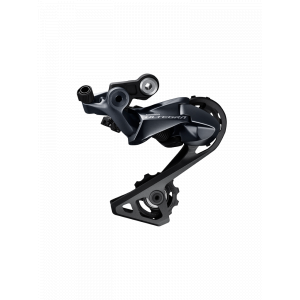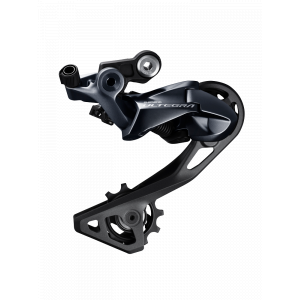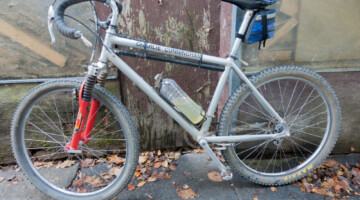Wilier Triestina takes the crown of having its name on some of the most unique bikes we’ve covered.
A few years ago, it left an oversized impression on us with its steel Jaroon + monster cross bike, complete with 3” tires. That bike remains in our review Hall of Fame due to its ride-everything spirit and massive tire volume.
Way back in 2016, it was the infamous brand that Femke Van den Driessche used to spark controversy with a pedal-assist motor at the 2016 UCI Cyclocross World Championships. We also saw salden.nl selling Wiler cyclocross bikes pre-equipped with a hidden Vivax motor. Wilier had no role in either of these electric situations but did supply up-and-coming pro Laura Verdonschot with a sleek cyclocross bike for CrossVegas that was not available in the States.
Now the company is out to make another big impression in the hot cycling segment of gravel, both with the battery-powered eADVENTURE bikes and the wildly shaped Jena carbon gravel bike. We opted to avoid e-bike controversy and picked a Wilier Triestina Jena to review.
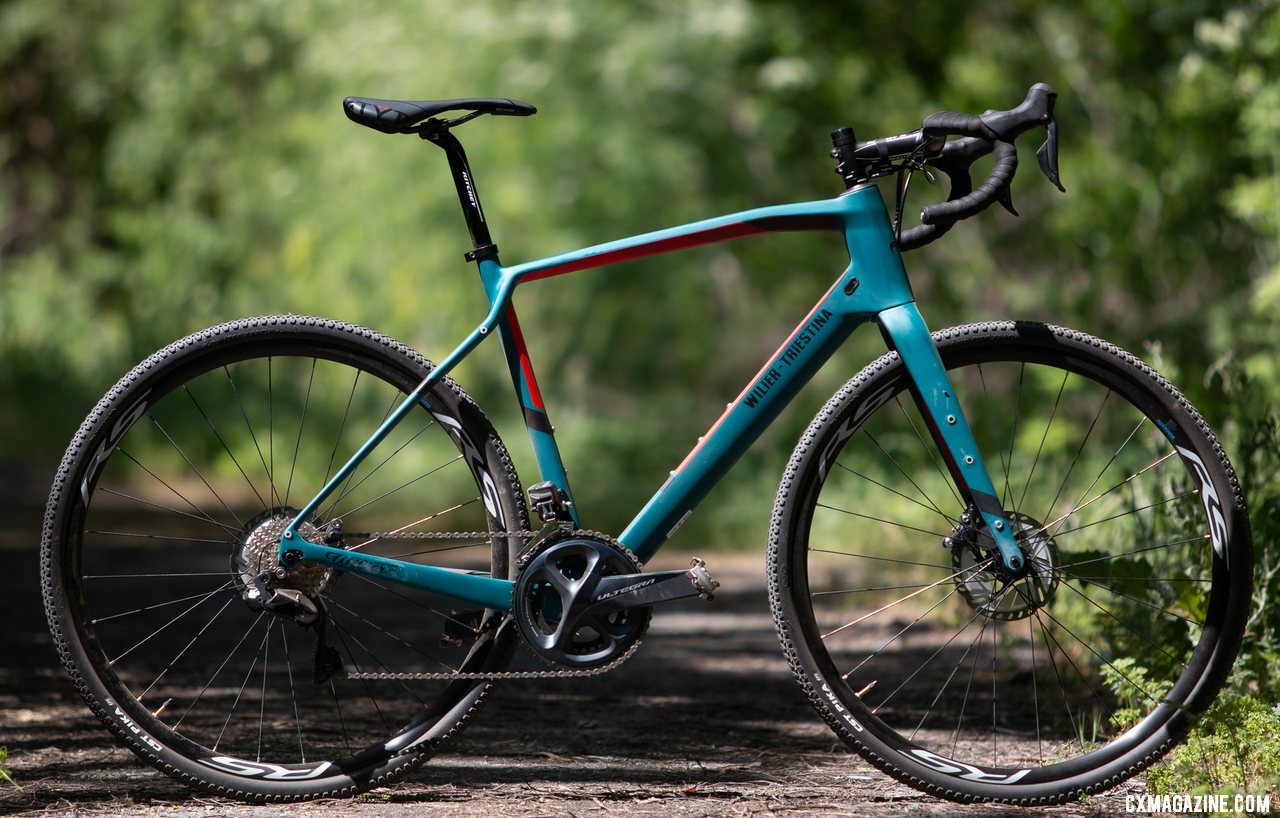
The Wilier Triestina Jena carbon gravel bike comes in five sizes and six builds. © A. Yee / Cyclocross Magazine
Is the Italian brand’s unique-looking gravel bike the right choice for your next escape from your desk and the masses? Read on for my review.
The Wilier Trestina Jena Frame:
The Jena’s large, shaped tubes certainly don’t offer visual hints of a lightweight bike, but Wilier Triestina reports that a size medium painted frame weighs just 995 grams, with a companion fork tipping the scales at 450 grams. That’s a lightweight package that shouldn’t hold back any gravel racer, even Crusher or Lost and Found contenders.
Wilier describes the Jena as “designed to satisfy any of your needs, whether it is performance on dirt roads and single track, or adventure, exploration, and bikepacking.” To that end, there are a plethora of mounts, including two-bolt mounts on the fork legs, lowrider mounts, fender mounts and the standard two bottle mounts inside the main triangle. There’s also a good chance it will meet your needs because it comes in five different frame sizes, spanning a range in reach from 363mm to 401mm.
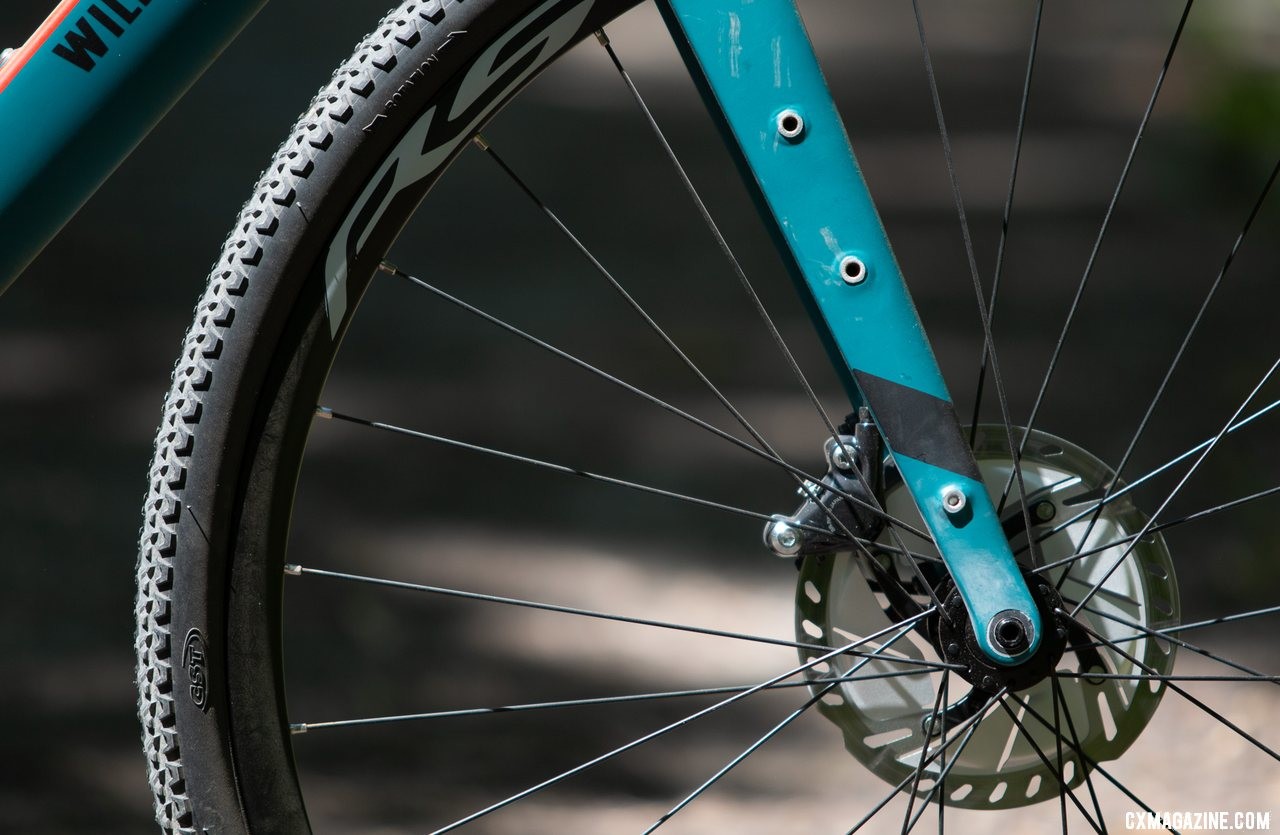
The Wilier Triestina Jena carbon gravel bike has room for a bottle mount on each fork leg, with a lowrider rack option. © A. Yee / Cyclocross Magazine
Ready for adventure? The bike is advertised to have clearance for 700c x 44mm tires or 1.95” wide tires in the 650b/27.5” diameter. Without big side knobs or mud, I suspect you could get away with even bigger.
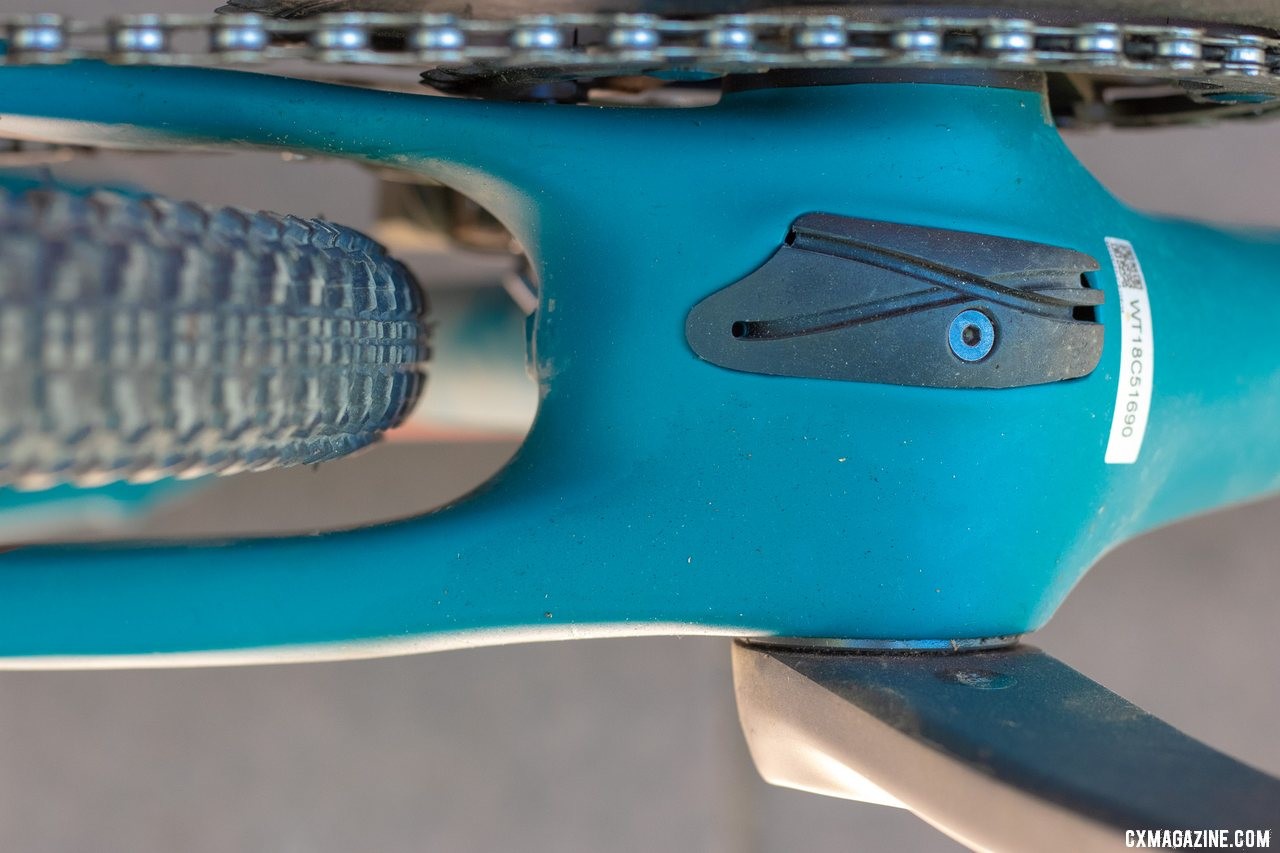
The Wilier Triestina Jena carbon gravel bike has lots of clearance around a 38mm tire. 44mm is the stated max. © A. Yee / Cyclocross Magazine
Ready to race? The Jena carbon frameset still has speed in mind. The frame incorporates Wilier’s Kamm Tail Design downtube, an airfoil-shaped downtube with a blunt tail that is said to offer an aerodynamic edge.
Our size large Jena paired relatively short chainstays (42.3cm) with relatively standard angles (71.5 head angle, 73.1 seat angle) and a tall head tube (17.5cm). The end result created a configuration with a 391mm reach and 608mm stack. With a big front tire, there’s a little bit of toe overlap (with a size 45.5 shoe and rearward cleat position). Thanks to a sloping, kinked top tube and relatively low bottom bracket (7.5cm drop), standover clearance is generous.
The test bike came with an uncut steerer, allowing for an even more upright position if the generous head tube doesn’t put you in a comfortable position. Slammed stem racers might seek a negative rise stem to find their aerodynamic sweet spot.
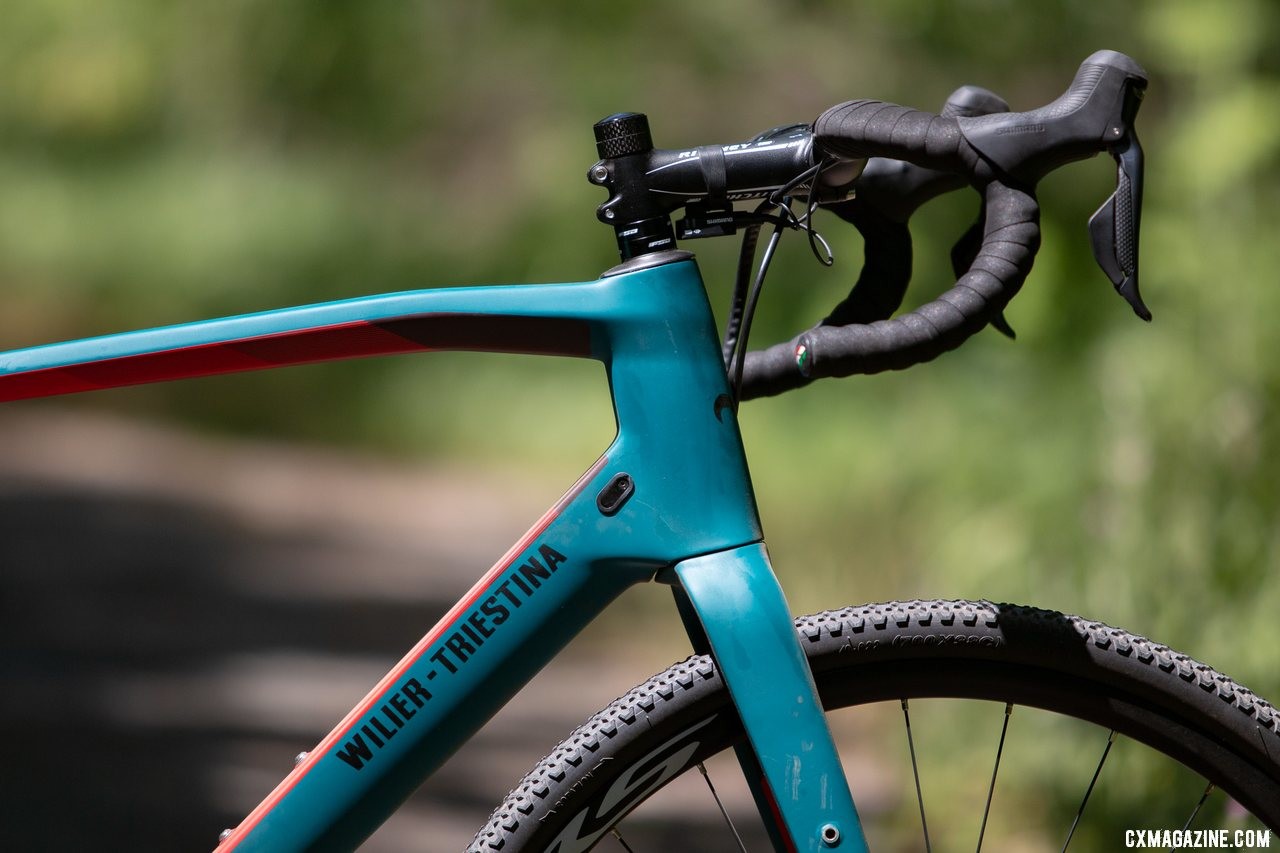
The Wilier Triestina Jena carbon gravel bike pairs a long stem with a generous head tube length and riser drop bar. The steerer came uncut, but we left some extra for the next rider. © A. Yee / Cyclocross Magazine
The 2019 model comes in the blue/red color scheme of our test bike (looks more like teal/red-orange) and also a grey/blue design. For 2020, a black color scheme is also coming.
The Wilier Trestina Jena Build:
The Jena is available in a whopping six different variants. One is based on SRAM Rival 1, two on Shimano 105 and three on Shimano Ultegra (one Di2, two mechanical). Wilier Triestina offers the mechanical Ultegra and 105 builds in both 700c and 650b wheel options.
Our test build, the $5,499 top-spec Shimano Ultegra 8070 Di2 version, came with compact 50/34t gearing and an 11-30t cassette and Shimano’s RD-R8050-SS short cage Ultegra Di2 rear derailleur (more on that later). The entire package weighed 19.7 pounds without pedals.
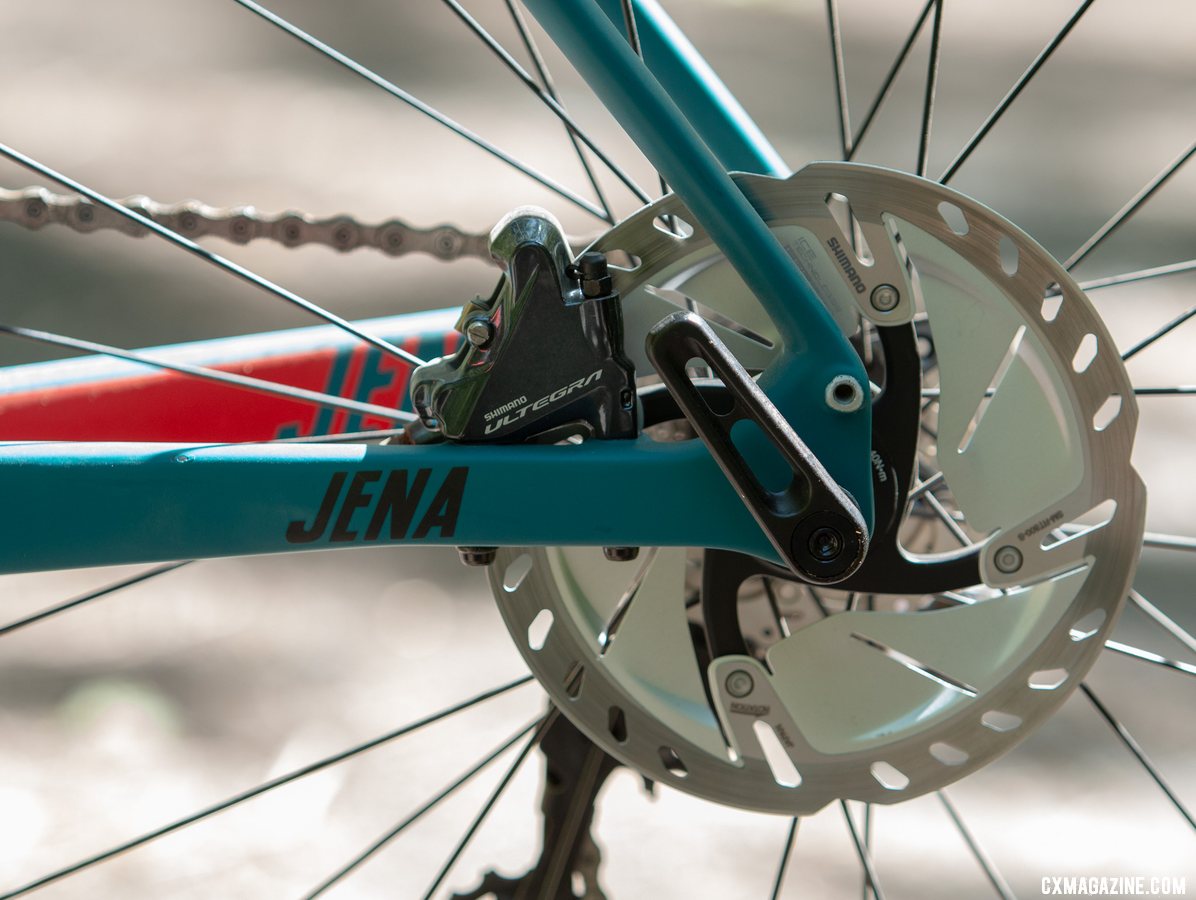
Flat mount and 12mm thru axle of course. The Wilier Triestina Jena carbon gravel bike. © A. Yee / Cyclocross Magazine
Handling duties were given to a Ritchey Comp cockpit with the Ergomax handlebar, 4 Axis stem and Comp 2 seat post. The supplied Ritchey Comp stem, at 120mm long, felt and looked decidedly old-school in this day and age, while the swoopy bar felt quite modern. The bar has 1cm of rise, a 5-degree rearward sweep at the tops and a 12-degree flare at the drops. The rise, paired with the generous head tube length (17.5cm, size Large) offers plenty of room for an upright, see-the-sights position, especially once you reign in the stem length.
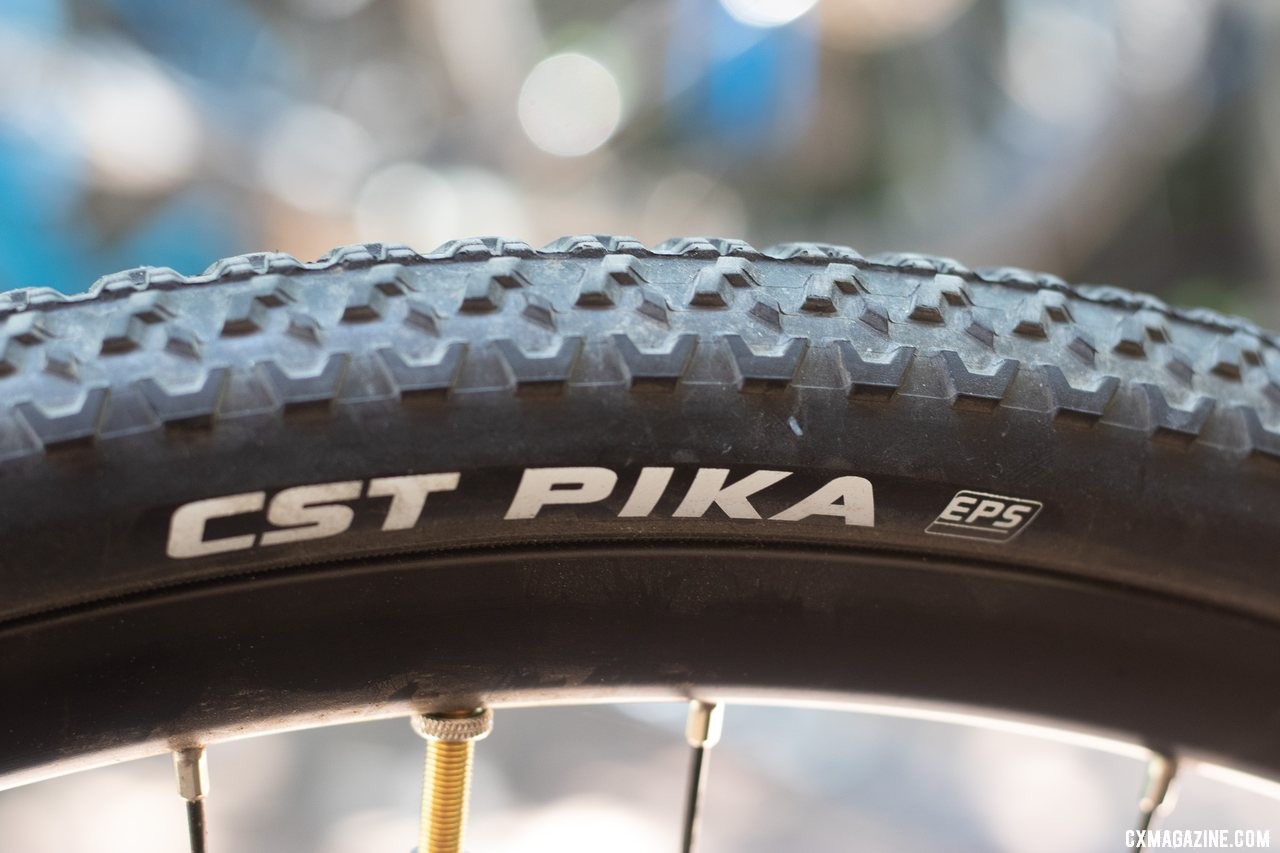
Our Wilier Triestina Jena carbon gravel bike came with non-tubeless CST Pika wire bead tires. The tread was grippy in loose conditions, but the Shimano wheels are not tubeless compatible. © A. Yee / Cyclocross Magazine
The package rolled on Shimano’s RS170 disc wheels. The disc clincher wheels are 105-level components and are quite heavy at just under 2,100 grams. Surprisingly, they’re not tubeless-ready. Consistent with the choice in wheelset is the non-tubeless, wire bead 38mm CST Pika gravel tires on our test bike. The official spec calls for Vittoria 700c x 37mm Terreno Zero rubber.
Without the heavy wheels, the package weighs a respectable 11.2 pounds (a CXM trademark measurement for wheel swappers). So with a wheel swap and lighter tires, an 18-pound bike is achievable.
Altogether, it feels either like a relatively budget build with a surprisingly high-end drivetrain or top-shelf bike with some cost-cutting measures.
The Wilier Trestina Jena Ride:
What do you want out of a gravel bike? A road bike feel with fatter tire? A stable ride for all-day riding and scenery oggling?
Out of the box, the Jena is set up to stretch you out and have you chasing roadies. It’s ready to be pushed like a road bike on gravel roads and pavement. It’s not the slack, mountain-bike inspired geometry we’ve seen on Kona and Cannondale recently. Short chainstays, a moderate head angle and relatively big bottom bracket drop make the bike feel more road bike-like than an adventure or bikepacking rig, with one exception.
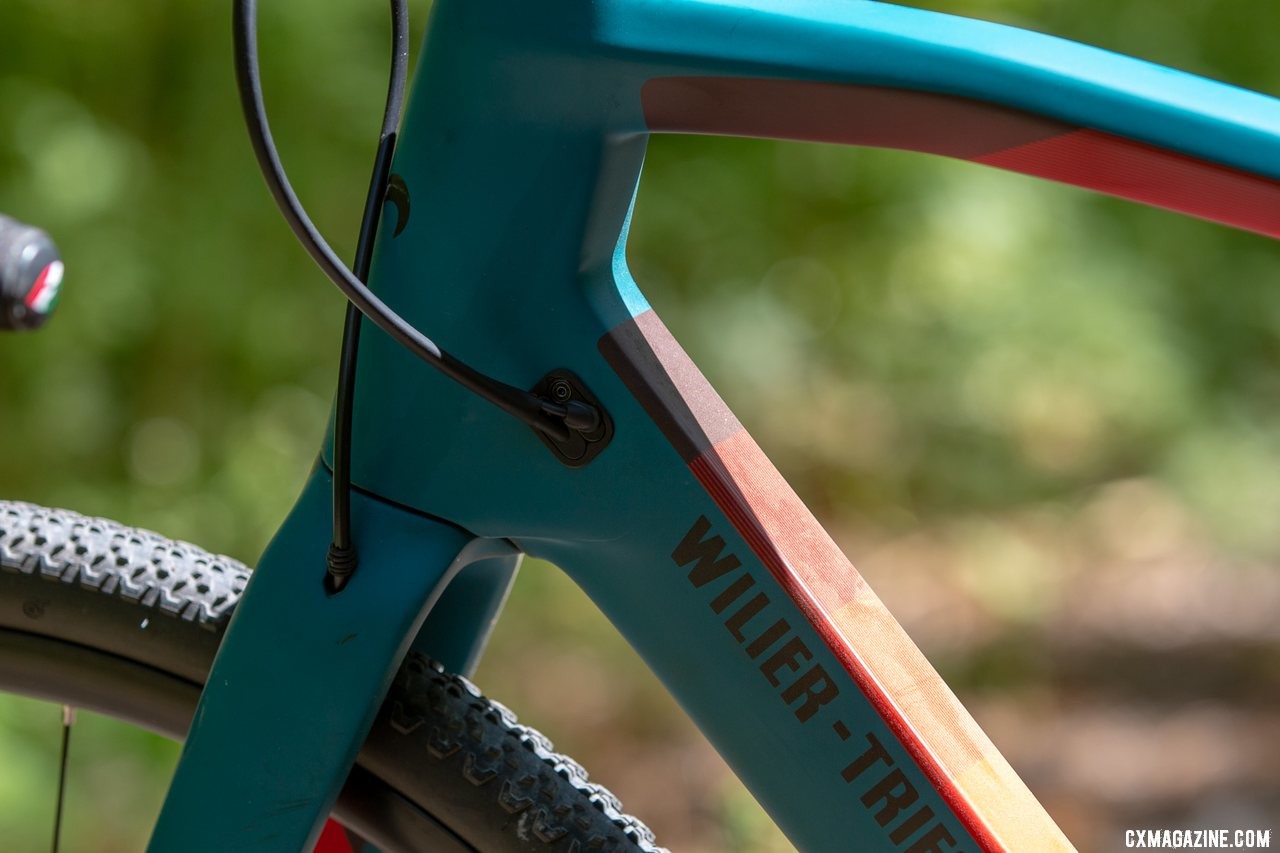
The Wilier Triestina Jena carbon gravel bike features internal routing for wires, cables and hoses in the frame and fork. © A. Yee / Cyclocross Magazine
The Jena feels at home on the road but likes going straight. Thanks to its 120mm-long Ritchey 4-Axis stem, the Wilier Trestina Jena feels stable, but slow, when steering. Yes, I remember days when 120mm stems were the norm on a 57cm bike, but paired with today’s geometry and reach numbers that we’re used to, the steering feels noticeably slow.
That’s a positive attribute if the reach to the bars fits and you ride long, straight gravel or dirt roads. It’s a bit sluggish for threading tight, twisty singletrack. Since most gravel rides and events are more of the former, Wilier likely hit its target market. But if you’re like us and like to ride one bike on trails, gravel and cyclocross, pick the size based on reach and slap on a shorter stem. For a brief period, I did exactly that, with a Redshift Sports 100mm ShockStop stem.
How do all those shaped carbon tubes translate into ride quality? First, with its heavy wheelset and wire bead CST tires, it’d be hard to claim a supple, comfortable ride out of the box. Swap to high-quality tubeless tires and wheels and the ride comes alive. It’s plenty stiff up front and out back, but big bumps aren’t jarring—there’s a hint of compliance in the rear triangle.
Power up steep climbs and the short chainstays are your friend. The CST Pika tires have a good, versatile tread that offer good grip on more than groomed gravel roads. You still have a chance of avoiding tire spin or sliding out on loose dirt and gravel. I just wish the whole setup was tubeless.
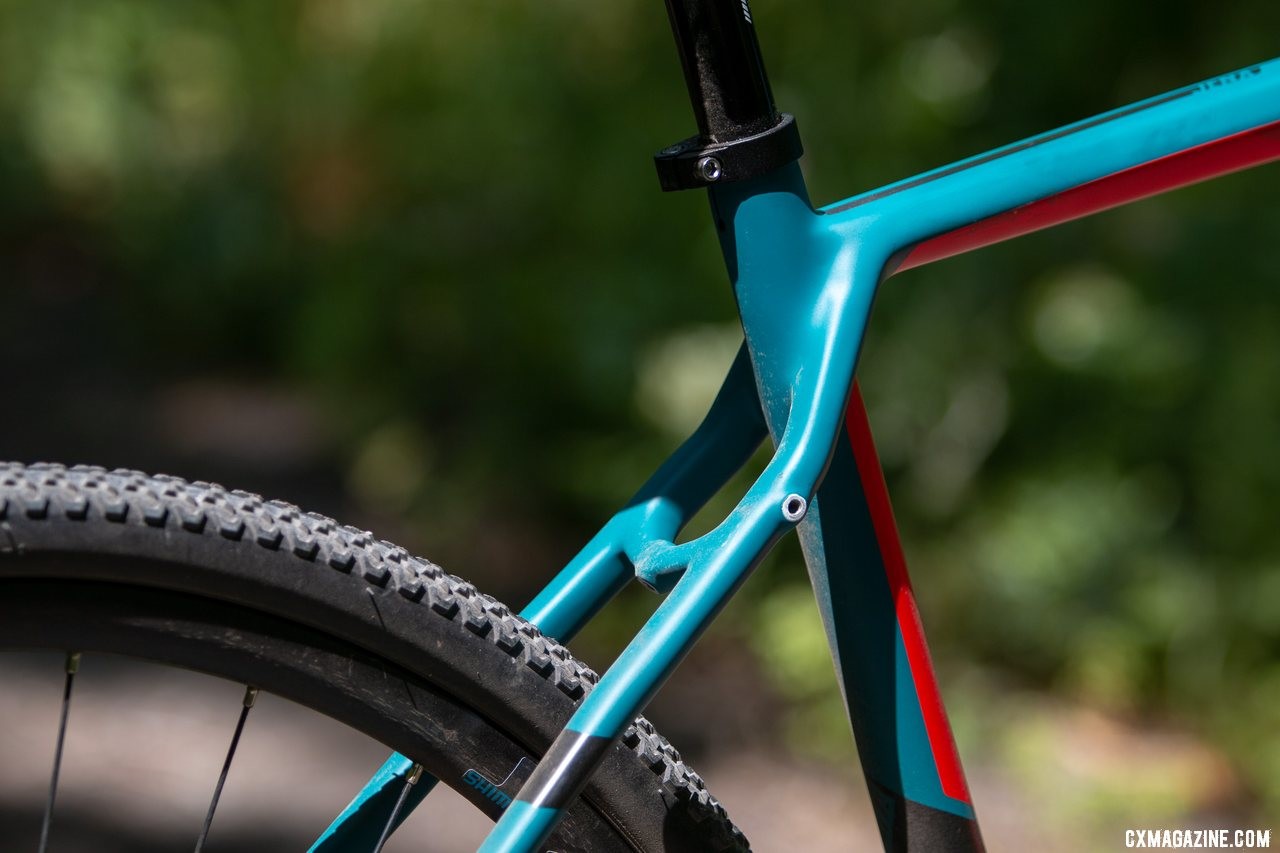
The Wilier Triestina Jena carbon gravel bike features radically shaped and curved tubes, and is ready for your rack or fenders. © A. Yee / Cyclocross Magazine
Wilier says its Kamm tail downtube shape adds an aero advantage, but it’d be just hot air if I said I noticed any speed gains in my normal riding.
Regarding the build, the Ultegra Di2 drivetrain is the shining star. The quick, light action shifting swaps gears with predictable speed regardless of your energy level and is configurable with different shift modes. I rode most of the time in Semi-Synchro (S1) mode, meaning the small two cogs were blocked in the small chainring, but the rear derailleur would compensate with each front shift.
Some will love and some will hate the Ritchey Ergomax bar. I grew to like it. The top sweep and drop flare were comfortable.
The Wilier Trestina Jena Limitations:
The Jena frame, geometry and ride quality offer versatility and compatibility with today’s high-volume tires, electronic drivetrains and riding styles. If the frame’s lines and color scheme agree with you, the Jena frameset is a fine foundation for a gravel racer or do-it-all bike. Briefly, it was my intended ride for the Lost and Found race. It’s the part selection that left me longing for some upgrades.
While the Shimano Ultegra Di2 drivetrain didn’t miss a shift, I still missed shifts at the low end of the gear range. The 50/34t compact crankset offers enough low gear potential, but the 11-30t cassette is quite tall for most of us non-pros with hilly terrain. I’ll admit it. I’ve grown accustomed to a 1:1 gear or lower on gravel bikes, and if I’m going to enter a gravel event or tackle the local trails in the hills, I want something lower than a 34×30.
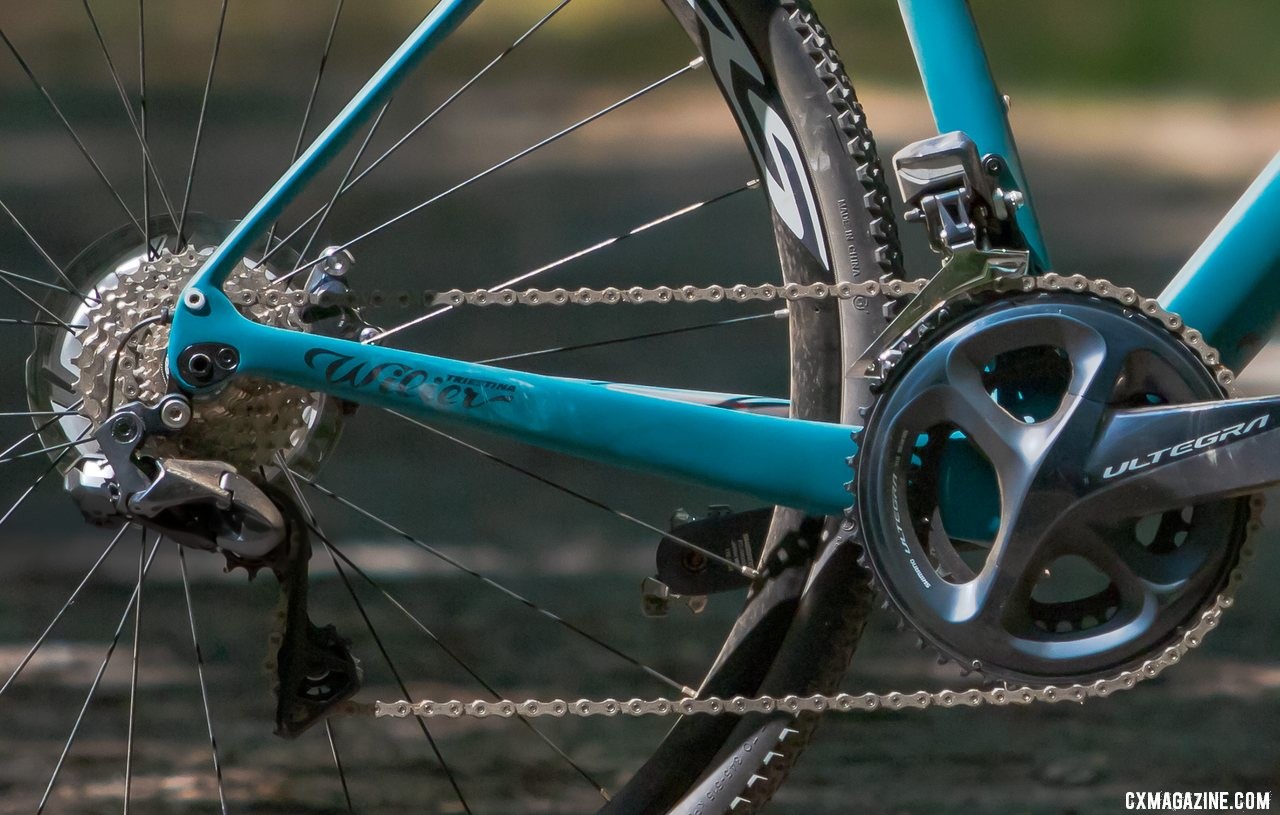
The Wilier Triestina Jena carbon gravel bike with the Ultegra Di2 build would have been more capable with a GS cage rear derailleur, instead of the stock short cage. © A. Yee / Cyclocross Magazine
Going lower requires just a cassette swap and a few more chain links, right? It’s not that easy. Sadly, the RD-R8050 derailleur is the SS variant, which maxes out at a 30t cog. To use the excellent 11-34t 11-speed cassette from Shimano, you need a GS (medium cage) derailleur. That’s an expensive upgrade with Di2. Wilier says the short cage derailleur was necessary for the stock 11-30 cassette, but Shimano states the medium cage would work fine with something as tight as 11-28t.
A short cage derailleur as the default spec is an unnecessary gearing limitation and prevented the Jena from being my bike of choice for the 2019 Lost and Found gravel race. The clutch-based RD-RX805 would have a been a better choice for gravel gearing and off-road terrain. Wilier says a customer can request a GS cage Ultegra R8050 rear derailleur with a bigger cassette, but I believe that should be the default option for a bike that is described as “designed to give you more freedom of choice when you go out for a ride.” It’s worth noting the Shimano mechanical builds have the same gearing limitations.
The heavy non-tubeless wheels, and wire bead non-tubeless CST tires on our test bike also feel like an unwelcomed area of cost-cutting just to hit a price point. We complain when companies offer bikes with tubeless wheels without tubeless tires but serving up top-shelf build without an easy way to shed inner tubes feels inexcusable.
The production bike is spec’d with Vittoria Terreno Zero 37mm tires, which are tubeless-ready, but sadly the Shimano RS170 wheelset is not. Thankfully the more affordable Ultegra mechanical options, featuring Mavic Allroad 700c and Miche 988RR 650b hoops, come with tubeless-ready wheels and tires.
I’d expect the $5,499 Di2 model to have the lightest wheels of all builds and be ready for tubeless use, but it does not. If this was a road “endurance” model, I might give this a pass, but for a dedicated gravel bike? That’s a deal-breaker.
As a result, most of my miles on the Jena were spent rolling on other wheels. The $3k Fuji Jari 1.1, in comparison, forgoes electronic shifting but adds a clutch RX800 rear derailleur, WTB i23 tubeless wheels and Panaracer GravelKing tires, all for $2,500 less.
The Verdict:
Wilier Triestina did a nice job building a unique-looking lightweight frame that’s quite capable of handling a variety of terrain and riding. The frame itself checks most of the boxes of what we look for in a gravel bike, and it can also pull duty as a road, cyclocross or bikepacking bike while not looking like a cookie-cutter open mold machine. I’d love to build a frameset up with an eTap AXS or GRX group and the parts of my choice to create a dream gravel ride.
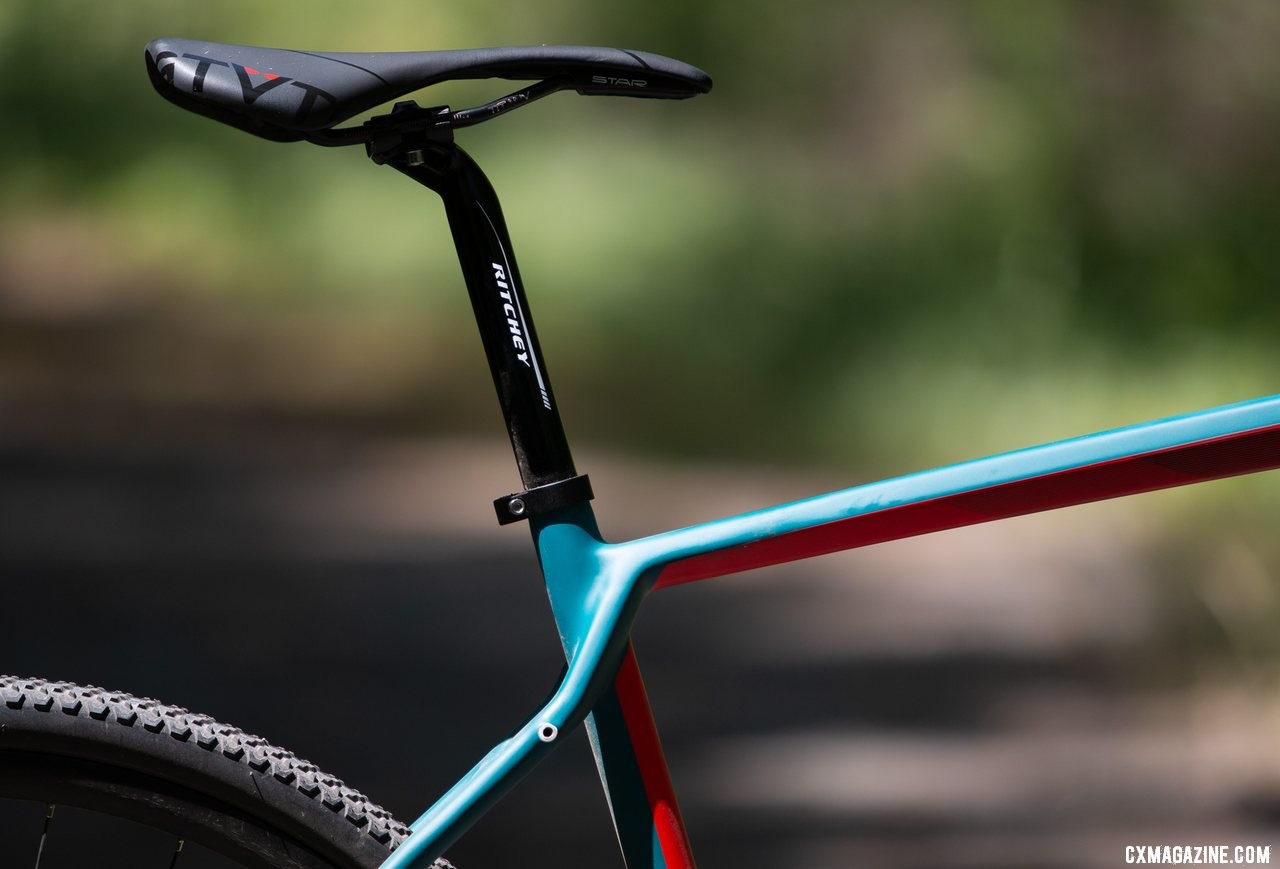
The Wilier Triestina Jena carbon gravel bike has quite a bit of standover clearance. It uses a 27.2mm seat post, offering some comfort. © A. Yee / Cyclocross Magazine
Unfortunately, the build kit of the flagship Di2 model cuts too many corners and results in a parts package that doesn’t match the level of the drivetrain. While I wouldn’t hesitate to recommend the frame as a basis for a fun, versatile gravel ride, other build variants or Wilier’s expected future GRX model may be better choices if you don’t want to instantly upgrade wheels, a rear derailleur, cassette and stem to end up with a lower gear and lower pressure.
Thankfully Wilier offers plenty of build choices for the Jena, and to be clear, I picked the Di2 build without studying the full specs. Although we haven’t ridden it, the SRAM Rival 1 model, which could be as much as $1,500 less, might actually be more gravel-ready if you welcome a single-chain-ring drivetrain. It arrives with a 38×42 low gear, Mavic Allroad tubeless wheels and Yksion XL 40mm tubeless tires and should be more ready for more rugged adventure out of the box.
See the specs and photo gallery below.
More info: wilier.com
Wilier Triestina Jena Ultegra Di2 Gravel Bike Photo Gallery:














